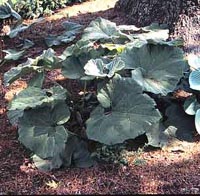Resource Library
Plant of the Week: Japanese Butterbur
The University of Arkansas System Division of Agriculture does not promote, support or recommend plants featured in "Plant of the Week." Please consult your local Extension office for plants suitable for your region.
Plant of the Week
Japanese Butterbur
Latin: Petasites japonicus 'Giganteus'

How could you not be intrigued by a plant listed in the catalog as "Dinosaur Food"? This plant looks like it’s straight off of the set of one of Steven Spielberg’s Jurassic Park flicks, complete with giant lizards merrily munching on its enormous leaves. Unlike the dinosaurs, the Japanese Butterbur is not likely to become extinct any time soon. The fast-growing herbaceous perennial is one of the new plants making its way into our gardens.
What makes the Japanese butterbur impressive are the 3-4 foot wide, two-lobed rounded leaves. The dark green, rough-textured leaves are held aloft on stout petioles 3-4 feet long that arise from a central crown and form large mounds. A variegated version is also offered, but its leaves are only about half the size of the green-leafed selection.
Japanese butterbur is a member of the daisy family. It produces blooms in late winter, before any foliage appears. Clusters of yellow-green blooms, more bizarre than beautiful, push from the soil in March like some odd botanical snow-cone. The plants are dioecious so these vegetatively propagated plants won’t make seeds without a member of the opposite sex present.
It’s good that the Japanese butterbur does not produce seeds, because this is a plant that spreads well enough without them. It typically grows in moist alluvial sites in full sun or partial shade. It produces a network of pencil-sized rhizomes that spread in all directions from the original plant. It begins to colonize an extensive area after its second or third year.
Because of its tendency to run, the Japanese butterbur should be planted where its spread can be closely monitored, or where it can be allowed to roam more or less at will.
The petioles have been eaten in Japan, but it’s not a common food in modern Japanese culture. Its large petioles, when dried at the end of the season, are said to make good walking sticks.
Before we turn a plant such as Japanese butterbur loose in our landscape, it would behoove all gardeners, acting as caring environmentalists, to carefully evaluate the possibility of escape. No one wants to be responsible for introducing the next kudzu.
Like all plants that spread by underground rhizomes, its reach can be limited by mowing. A mowed swath 10-feet wide will prevent its invasion into unwanted areas. If no such barrier can be established, make sure it will not move beyond the limits of your own property.
In the garden, the enormous foliage of Japanese butterbur creates a tropical, exotic feel. Use it in the wild garden or as a background planting for plants such as hostas and other shade lovers.
The plant grows most quickly in deep, fertile sites, but it’s also tolerant of heavy clay soil. It’s sensitive to dry soils and wilts quickly when water becomes short. It grows well in medium shade or full sun; but in sunny sites, some protection from strong wind is advisable to prevent injury to the large leaves.
By: Gerald Klingaman, retired
Extension Horticulturist - Ornamentals
Extension News - July 20, 2001
The University of Arkansas System Division of Agriculture does not maintain lists of retail outlets where these plants can be purchased. Please check your local nursery or other retail outlets to ask about the availability of these plants for your growing area.